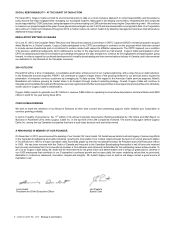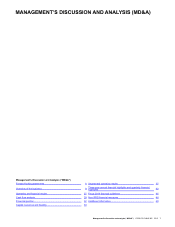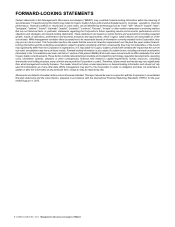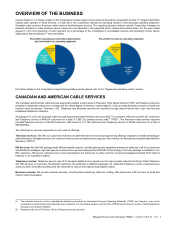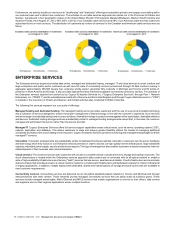Cogeco 2013 Annual Report Download - page 17
Download and view the complete annual report
Please find page 17 of the 2013 Cogeco annual report below. You can navigate through the pages in the report by either clicking on the pages listed below, or by using the keyword search tool below to find specific information within the annual report.16 COGECO CABLE INC. 2013 Management's discussion and analysis (“MD&A”)
For the 2013 fiscal year, Cogeco Cable achieved or surpassed most of its key performance indicators compared to its revised projections issued
on July 10, 2013. Revenue, operating income before depreciation and amortization, operating margin, acquisitions of property, plant and equipment,
intangible and other assets, free cash flow and capital intensity targets were achieved when compared to the revised projections. For further
details on the Corporation's operating results, please refer to the “Operating and financial results”, the "Segmented operating results" and the
"Cash flow analysis" sections.
Profit for the year amounting to $185.1 million under-achieved the revised projection issued on July 10, 2013, mainly due to the the increase of
depreciation and amortization expense generated by the recent acquisitions, partly offset by the improvement of operating income before
depreciation and amortization explained above and the decrease in income taxes. For further details on the Corporation's operating results,
please refer to the “Operating and financial results” section.
OPERATING INCOME BEFORE DEPRECIATION AND AMORTIZATION AND OPERATING
MARGIN
Operating income before depreciation and amortization and operating margin are benchmarks commonly used in the telecommunications industry,
as they allow comparisons with companies that have different capital structures and are more current measures since they exclude the impact
of historical investments in assets. Operating income before depreciation and amortization evolution assesses Cogeco Cable's ability to seize
growth opportunities in a cost-effective manner, to finance its ongoing operations and to service its debt. Operating income before depreciation
and amortization is a proxy for cash flow from operations(1). Consequently, operating income before depreciation and amortization is one of the
key metrics used by the financial community to value the business and its financial strength. Operating margin is calculated by dividing operating
income before depreciation and amortization by revenue. In the 2012 annual report, the Corporation projected operating income before depreciation
and amortization of $614 million for fiscal 2013, which was then increased to $780 million in the revised projections issued on July 10, 2013 in
order to reflect the acquisitions of Atlantic Broadband and PEER 1 in the first and second quarters of fiscal 2013, respectively, as well as the
improvement in operating income before depreciation and amortization in the Canadian cable services segment resulting essentially from cost
reduction initiatives. Consequently, operating income before depreciation and amortization for the 2013 fiscal year amounted to $781 million,
achieving the Corporation's revised projections. The operating margin reached 46.1% for the fiscal year, compared to the revised projections of
46.0% issued on July 10, 2013.
FREE CASH FLOW
Free cash flow is defined as cash flow from operations less acquisitions of property, plant and equipment, intangible and other assets. Furthermore,
the financial community closely monitors this indicator since it measures the Corporation's ability to repay debt, distribute capital to its shareholders
and finance its growth. Fiscal year 2013 free cash flow amounted to $150 million, surpassing the Corporation's revised projections mainly due
to the improvement in operating income before depreciation and amortization and the decrease in current income taxes as a result of the tax
structure related to the recent acquisitions, partly offset by the increase in financial expense and acquisitions of property, plant and equipment,
intangible and other assets.
PSU GROWTH AND PENETRATION OF SERVICE OFFERINGS
As at August 31, 2013, PSU reached 2,465,780 of which 1,980,122 come from the Canadian cable services segment and 485,658 from the
American cable services segment. In the 2012 annual report, the Corporation projected PSU growth of 50,000 for fiscal 2013, which was then
reduced to 15,000 with the revised projections issued on July 10, 2013 in order to reflect the more competitive environment in the Canadian
services segment combined with service category maturity and tighter customer credit qualifications. However, only 5,546 PSU were added,
which is under our revised projection. In the Canadian cable services segment, PSU increased by 5,068 compared to an increase of 73,645
PSU for the comparable period of the prior year, mainly as a result of service category maturity and a more competitive environment in all services.
In the American cable services segment, PSU increased by 478 stemming primarily from additional HSI services, offset by losses in Television
services. For further details please consult the customer statistics on the Canadian and American cable services sections under the "Segmented
operating results" section. Furthermore, as a result of the Corporation's diversification in product and services, PSU growth will no longer be
used as a key performance indicator starting on fiscal 2014.
CAPITAL INTENSITY AND ACQUISITIONS OF PROPERTY, PLANT AND EQUIPMENT,
INTANGIBLE AND OTHER ASSETS
The capital intensity ratio is defined as amount spend for acquisitions of property, plant and equipment and intangible assets divided by revenue
generated for the comparable period. The capital intensity ratio measures the Corporation's investment in capital expenditures in order to support
a certain level of revenue. For the 2013 fiscal year, the Corporation reached acquisitions of property, plant and equipment, intangible and other
assets of $408 million over revenue of $1.7 billion for a capital intensity of 24%, thus achieving its revised guidelines. Compared to fiscal 2012,
capital intensity decreased from 29% in fiscal 2012 to 24% in fiscal 2013. In fiscal 2012, the Canadian cable services segment achieved a
comprehensive upgrade of its networks which considerably decreased its capital intensity from approximately 26% for the year ended August
31, 2012 to approximately 19% for the year ended August 31, 2013. The Corporation expects to use the increased free cash flow to reduce its
indebtedness and further invest in its Enterprise services segment. For the 2013 fiscal year, acquisition of property, plant and intangible assets
slightly achieved the Corporation's revised guidelines.


